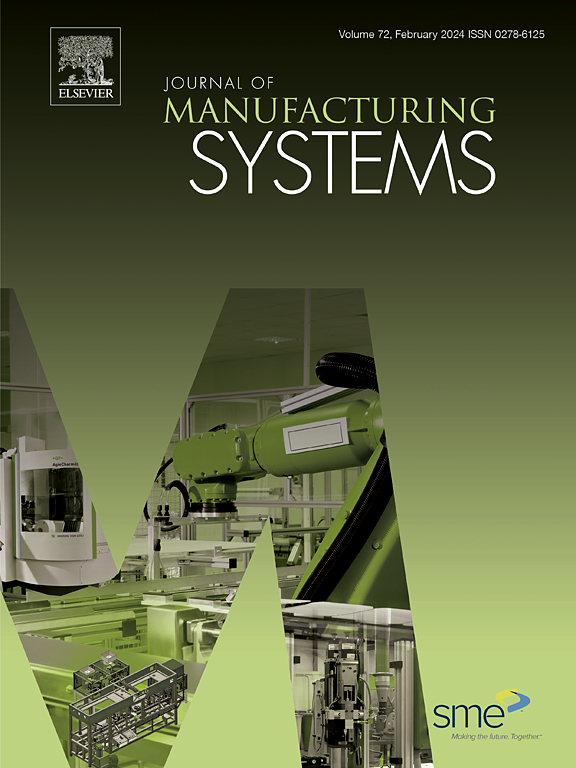面向智能制造的数字孪生:通过多传感器融合的辅助设备自适应控制智能工具实时机器状态监测
IF 14.2
1区 工程技术
Q1 ENGINEERING, INDUSTRIAL
引用次数: 0
摘要
与传统的监测方法相比,多传感器融合智能工具具有多种优势,包括全过程监测和更广泛的应用范围(例如,平面,弯曲和复杂表面)。当与人工智能模型集成用于工具状态监测时,这些工具具有较强的泛化能力和较高的预测精度。还可以调整机床工艺参数,延长刀具寿命。然而,切削参数的准原位调节范围有限,难以实现完全的工况适应性。辅助设备的引入可以增强工艺适应性。此外,自适应控制机构可以通过调节开关参数来调节加工过程,从而降低能耗。尽管有这些优势,智能工具的联动控制机制仍不清楚,现有的工具磨损模型难以适应多种情况下的可变工作条件。为了解决这些挑战,本文探讨了智能刀具加工过程的数字孪生建模和应用。首先,建立了数字双驱动刀具加工过程模型,并对具体应用场景和方法进行了探索。其次,建立了一种基于数字孪生的辅助设备自适应耦合机制,在提高加工质量的同时降低了能耗;并对刀具磨损在线识别模型进行了增强,提高了模型的通用性,降低了工况变化时模型重构的成本,实现了高质量加工条件下的绿色智能制造。本文章由计算机程序翻译,如有差异,请以英文原文为准。
Toward digital twins for intelligence manufacturing: Self-adaptive control in assisted equipment through multi-sensor fusion smart tool real-time machine condition monitoring
Compared to traditional monitoring methods, multi-sensor fusion smart tool offers several advantages, including full-process monitoring and a broader range of applications (e.g., flat, curved, and complex surfaces). When integrated with artificial intelligence models for tool state monitoring, these tools provide strong generalization capabilities and high prediction accuracy. They can also adjust machine tool process parameters to extend tool life. However, the quasi-in-situ regulation of cutting parameters has a limited scope, making it challenging to achieve full working condition adaptability. The introduction of assisted equipment can enhance process adaptability. Furthermore, adaptive control mechanisms can regulate the machining process to reduce energy consumption by adjusting the opening and closing parameters. Despite these advantages, the linkage control mechanism for the smart tool remains unclear, and existing tool wear models struggle to adapt to variable working conditions across multiple scenarios. To address these challenges, this paper explores the digital twin modeling and application of smart tool machining processes. First, a digital twin-driven tool machining process model is developed, with an exploration of specific application scenarios and methods. Secondly, an adaptive coupling mechanism for assisted equipment based on digital twins is established, which simultaneously improves machining quality and reduces energy consumption. Additionally, the online tool wear identification model is enhanced to increase its generalization and reduce the cost of model reconstruction when working conditions change, thus enabling green intelligent manufacturing under high-quality machining conditions.
求助全文
通过发布文献求助,成功后即可免费获取论文全文。
去求助
来源期刊

Journal of Manufacturing Systems
工程技术-工程:工业
CiteScore
23.30
自引率
13.20%
发文量
216
审稿时长
25 days
期刊介绍:
The Journal of Manufacturing Systems is dedicated to showcasing cutting-edge fundamental and applied research in manufacturing at the systems level. Encompassing products, equipment, people, information, control, and support functions, manufacturing systems play a pivotal role in the economical and competitive development, production, delivery, and total lifecycle of products, meeting market and societal needs.
With a commitment to publishing archival scholarly literature, the journal strives to advance the state of the art in manufacturing systems and foster innovation in crafting efficient, robust, and sustainable manufacturing systems. The focus extends from equipment-level considerations to the broader scope of the extended enterprise. The Journal welcomes research addressing challenges across various scales, including nano, micro, and macro-scale manufacturing, and spanning diverse sectors such as aerospace, automotive, energy, and medical device manufacturing.
 求助内容:
求助内容: 应助结果提醒方式:
应助结果提醒方式:


